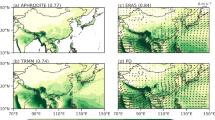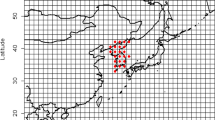Abstract
This paper deals with the future change projections of extreme cold events in relation to historical climate simulations, based on the comparison between two versions of the GFDL model, CMIP3 and CMIP5, in three regions of southeastern South America where these events are frequent. To this end, the compositions of up to five extreme events below 0 °C at 850 hPa were considered. They were derived from daily data collected from May to September of the NCEP/NCAR reanalysis and GFDL Coupled Atmospheric and Oceanic Global Circulation Model. The study periods run from 1961 to 1990 and from 2081 to 2100 for the most critical scenarios: A2 (GFDL-CM2) and RCP8.5 (GFDL-CM3). Sea level pressure, temperature, and wind were analyzed at 850 hPa and wind also at 250 hPa, for each of the areas under study, representing tropical (Area 1) and subtropical (Area 2 and Area 3) latitudes. The ability of the model to simulate the historical climate, represented by the reanalysis, increased as latitude decreased, CM3 version being better for subtropical latitudes than CM2. Depending on GFDL model version, temperature was higher or lower than those shown by the reanalysis in the tropical latitudes. In contrast, at subtropical latitudes, both versions of the model present lower values. An increase in mean temperature is expected in the future in the three areas, mainly at tropical latitudes (Area 1) according to both versions of the model, which is in line with the results reported by other global models. In Area 2, a further increase in temperature is projected in CM3 version, while, for Area 3, the greatest projection is in CM2 version. Changes are expected for the future climate, primarily explained by the configuration of the circulation fields, such as in the case of the subtropical areas in CM2, whose pattern is more related to that typically associated with radiative cooling, rather than the advective cooling shown in the historical climate. This result is in contrast with the results of the CM3 version, which displays a pattern associated with cold air advection from the south for both the historical and future climate. As regards the tropical area, both versions of the model reveal a considerable reduction in the number of extreme cold events.






Similar content being viewed by others
References
Alexander LV et al (2006) Global observed changes in daily climate extremes of temperature and precipitation. J Geophys Res 111:D05109. https://doi.org/10.1029/2005JD006290
Cavalcanti IFA, Müller GV, Andrade KM, Fernandez Long ME (2013) Cold air intrusions over southeastern South America—GFDL model behavior regarding climate simulations in the 20th century and future projections. Glob Planet Chang 111:31–42. https://doi.org/10.1016/j.gloplacha.2013.08.006
Ceccherini G, Russo S, Ameztoy I, Romero CP, Carmona-Moreno C (2015) Magnitude and frequency of heat and cold waves in recent decades: the case of South America. Nat Hazards Earth Syst Sci Discuss 3:7379–7409. www.nat-hazards-earth-syst-sci-discuss.net/3/7379/2015/. https://doi.org/10.5194/nhessd-3-7379-2015
Delworth T et al (2006) GFDL’s CM2 global coupled climate models—Part 1: formulation and simulation characteristics. J Clim 19(5):643–674
Dufresne JL et al (2013) Climate change projections using the IPSL-CM5 earth system model: from CMIP3 to CMIP5. Clim Dyn 40:2123–2165. https://doi.org/10.1007/s00382-012-1636-1
Easterling DR (2002) Recent changes in frost days and the frost-free season in the United States. Bull Am Meteorol Soc 83:1327–1332
Fenández Long, M.E., Müller, G.V., 2006. Annual and monthly trends in frost days in the Wet Pampa. Proceeding, 8th international conference on southern hemisphere meteorology and oceanography, 24–28. Foz do Iguazú, Brasil
Fenández Long ME, Müller GV, Beltrán-Przekurat A, Scarpati OA (2013) Long-term and recent changes in temperature-based agroclimatic indices in Argentina. Int J Climatol 33:1673–1686. https://doi.org/10.1002/joc.3541
Griffies SM et al (2011) The GFDL CM3 coupled climate model: characteristics of the ocean and sea ice simulations. J Clim 24(13):3520–3544. https://doi.org/10.1175/2011JCLI3964.1
IPCC (2007) Intergovernmental panel on climate change. In: Core Writing Team, Pachauri RK, Reisinger A (eds) Contribution of Working Groups I, II and III to the Fourth Assessment Report of the Intergovernmental Panel on Climate Change. IPCC, Geneva, Switzerland, p 104
IPCC (2013) Climate change 2013: the physical science basis. In: Stocker TF, Qin D, Plattner G-K, Tignor M, Allen SK, Boschung J, Nauels A, Xia Y, Bex V, Midgley PM (eds) Contribution of Working Group I to the Fifth Assessment Report of the Intergovernmental Panel on Climate Change. Cambridge University Press, Cambridge, United Kingdom and New York, NY, USA, p 1535. https://doi.org/10.1017/CBO9781107415324
Kalnay E et al (1996) The NCEP/NCAR 40-year reanalysis project. Bull Am Meteorol Soc 77:437–471
Marengo JA, Camargo C (2008) Surface air temperature trends in Southern Brazil for 1960-2002. Int J Climatol 28:893–904
Marengo, J. A., Nobre, C. A., Salazar L. F., 2010. Regional climate change scenarios in South America in the late XXI century: projections and expected impacts. Nova Acta Leopoldina NF 112, Nr. 384
Meehl GA, Washington WM, Ammann CM, Arblaster JM, Wigley TML, Tebaldi C (2004) Combinations of natural and anthropogenic forcings in twentieth-century climate. J Clim 17:3721–3727
Müller GV, Ambrizzi T (2007) Teleconnection patterns and Rossby wave propagation associated to generalized frosts over Southern South America. Clim. Dyn. 29:633–645. https://doi.org/10.1007/s00382-007-0253-x
Müller GV, Berri GJ (2007) Atmospheric circulation associated with persistent generalized frosts in Central-Southern South America. Mon Weather Rev 135(4):1268–1289
Müller GV, Berri GJ (2012) Atmospheric circulation associated with extreme generalized frosts persistence in Central-Southern South America. Clim Dyn 38(5–6):837–857. https://doi.org/10.1007/s00382-011-1113-2
Müller GV, Compagnucci R, Nuñez MN, Salles A (2003) Spatial analysis of surface circulation associated to frosts in the wet Pampas. Int J Climatol U K 23:943–961
Müller GV, Ambrizzi T, Nuñez M (2005) Mean Atmospheric circulation leading to generalized frosts in Central Southern South America. Theor App Clim Austria 82:95–112
Müller GV, Repinaldo CRR, Andrade KM, Cavalcanti IFA (2014) Proyecciones futuras asociadas a los eventos extremos fríos en el sudeste de Sudamérica sobre la perspectiva del modelo HadCM3. Meteor-Forschung 40:2 http://www.cenamet.org.ar/archivos/Muller.etal.EnEdicion2.pdf
Müller GV, Gan MA, Dal Piva E, Piccinini VS (2015) Energetics of wave propagation leading to cold event in tropical latitudes of South America. Clim Dyn 45(1–2):1–20 Available at: http://link.springer.com/10.1007/s00382-015-2532-2 [Accessed December 5, 2016]
Rusticucci M, Renom M (2008) Variability and trends in indices of quality-controlled daily temperature extremes in Uruguay. Int J Climatol U K 28:1083–1095
Rusticucci M, Marengo J, Penalba O, Renom M (2010) An intercomparison of model-simulated in extreme rainfall and temperature events during the last half of the twentieth century. Part 1: mean values and variability. Clim Chang 98:493–508. https://doi.org/10.1007/s10584-009-9742-8
Skansi ML et al (2013) Warming and wetting signals emerging from analysis of changes in climate extreme indices over South America. Glob Planet Chang 100:295–307
Solomon S (2007) Intergovernmental panel on climate change, intergovernmental panel on climate change, and working group I: climate change 2007: the physical science basis? Contribution of working group I to the fourth assessment report of the intergovernmental panel on climate change. Cambridge University Press, Cambridge, UK
Third National Communication on Climate Change (2015) Climate change in Argentina: trends and projections. National Ministry of Environment and Sustainable Development. (only available in Spanish), http://ambiente.gob.ar/tercera-comunicacion-nacional/ [Accessed November 1, 2015]
Vincent LA et al (2005) Observed trends in indices of daily temperature extremes in South America 1960–2000. J Clim 18:5011–5023
Wilks DS (2006) Statistical methods in the atmospheric sciences, 2nd edn. Elsevier Academic Press Publications, London, pp 627
Acknowledgements
The authors would like to thank Guillermo Berri for his comments and suggestions and the anonymous reviewers that contributed to improving the paper.
Author information
Authors and Affiliations
Corresponding author
Rights and permissions
About this article
Cite this article
Müller, G.V., Repinaldo, C.R.R. & Araneo, D.C. Extreme cold events in South America analyzed from a GFDL model perspective: comparison between CMIP3 and CMIP5 climate scenarios. Theor Appl Climatol 134, 453–466 (2018). https://doi.org/10.1007/s00704-017-2286-3
Received:
Accepted:
Published:
Issue Date:
DOI: https://doi.org/10.1007/s00704-017-2286-3




